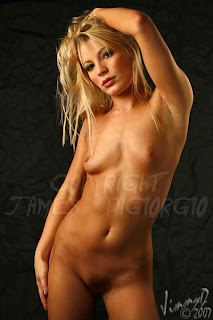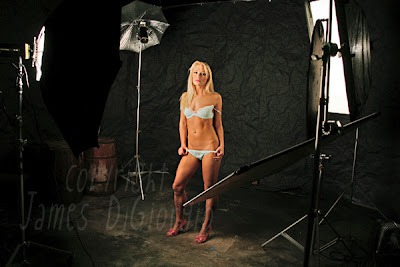 Today's Strobist features an interesting, "how-to" article titled, Using Specular Reflections as a Background Element. It includes examples of the technique as well as lighting diagrams.
Today's Strobist features an interesting, "how-to" article titled, Using Specular Reflections as a Background Element. It includes examples of the technique as well as lighting diagrams.Personally, and although the background thing is a neat trick, I think the title slightly belies a more useful practice: Lighting techniques that allow instruments to perform double-duty.
In my last update, I wrote about using less lights and still achieving effective results. In the Strobist's most recent update, a single light source--in this case, a small, portable, strobe--effectively lights the subject while also providing specular highlights on the background. (As his title proclaims!) It is useful and practical advice for photographers of all levels. But its applications are not limited to small, portable, strobes. In fact, they're mostly drawn from lighting techniques originally developed using lighting sources other than on-camera type strobes.
The reflecting-off-the-BG effect can be just as easily applied by shooters using other lighting gear: Monolights, hot lights, and that sort of stuff. In fact, although the Strobist's site is principally geared towards the use of instruments like Speedlites and other (typically) on-camera strobes, most of the Strobist's advice can be applied to nearly any artificial light source. I'm not trying to lessen the value of the Strobist's articles--small, portable, inexpensive, strobes are his site's hook--but those using other lighting sources should bear in mind that his articles have more universal applications when it comes to lighting people and other subjects.
In my style and genre of photography, I'm fairly confident I could achieve the same (or nearly the same) results I'm getting using small, portable strobes. Sure, there would be production, work flow, and application limitations to deal with but, in most cases, I think I could achieve very similar results. Why don't I routinely use on-camera strobes as off-camera light sources? Mostly, because I don't want to deal with the limitations of less power, slower recycle times, and smaller aperture light sources... that sorta stuff. Do I own any on-camera strobes? Yeah, 4 or 5 of them. Will I ever use them in multiple-light setups? Yep, in situations where it's more practical and convenient for me to do so.
The pretty girl at the top is another image of Aurora from last week's shoot. MUA was Vera. Images of Aurora were captured with a Canon 5D w/ 28-135 IS USM Zoom, ISO 100, f/5.6 @ 125th. Here's the lighting setup, pretty much the same as in my last update, but with the key and fill flipped the other way and, unfortunately, with the umbrella-modified monolight deciding, for whatever reason, not to fire. Because the strobe didn't fire, I had to drive some of the luminosity levels, in post, to better reveal the set. Unfortunately, due to the mis-fired strobe and my heavy-handed PS processing, the contrast in the (below) image is a bit flat. The BG, BTW, is simply dark gray seamless that's been crumpled and then rolled out and hung.


1 comment:
It is really nerdy and fun to know that the blogs I read cross reference each other. I wonder what the Strobist gets out of reading here... (:
...scott
Post a Comment